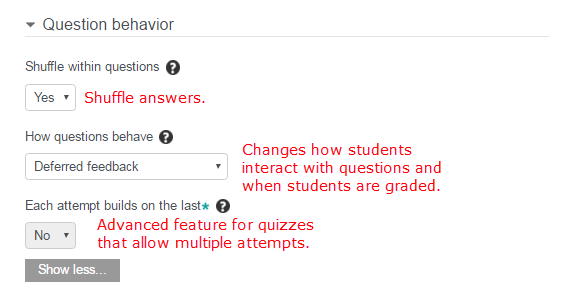Shuffle Within Questions
This section of Question Behavior allows you to choose “yes” or “no,” and defaults to “yes.” If “yes” is selected, answers to questions you enter will be shuffled as appropriate. This means Matching questions and Multiple Choice questions will have their answers appear in a random order to students. If you select “no,” these answer choices will appear to the students in the order in which you enter them into VSTAR.
How Questions Behave
There are several choices here, but the default choice is “deferred feedback.” If you would like students to answer all questions in the quiz, submit their answers, and then receive a grade, this is the option you should select. This is the most common option for quizzes and exams. Other options include:
- Adaptive mode and Adaptive mode (no penalties) – Allows students to have multiple attempts at the question before moving on to the next question. The question can adapt itself to the student’s answer, for example by giving some hints before asking the student to try again. In adaptive mode, students are penalized for answering the question incorrectly, and when you enter questions, you will set the penalty for each incorrect answer. In adaptive mode (no penalties), there will be no penalty for wrong answers, and students will be able to answer the question multiple times until they get the question correct. This may be a good option for reviews before exams.
- Interactive with multiple tries – After submitting one answer, and reading the feedback, the student has to click a ‘Try again’ button before they can try a new response. Once the student has got the question right, they can no longer change their response. Once the student has got the question wrong too many times, they are just graded wrong (or partially correct) and get shown the feedback and can no longer change their answer. There can be different feedback after each try the student makes.
- Immediate feedback – Similar to interactive mode in that the student can submit their response immediately during the quiz attempt, and get it graded. However, they can only submit one response, they cannot change it later.
- Deferred feedback or Immediate feedback with CBM (Certainty-based marking) – With CBM, the student does not only answer the question, but they also indicate how sure they are they got the question right. The grading is adjusted by the choice of certainty, so that students have to reflect honestly on their own level of knowledge in order to get the best mark. When a student answers a question they also have to state how sure they are of the answer: not very (less than 67%); fairly (more than 67%) or very (more than 80%). Their grading is then ajusted according to how certain they are, which means that for example if they answered correctly but were only guessing, their mark is adjusted from 1 to 0.33. If they answered wrongly but were very sure, their mark is adjusted from 0 to -2.
- Manual grading – This requires all questions to be manually graded; there is no immediate feedback. This may be a good option for quizzes that include a lot of short answer questions, otherwise, it’s generally better to let the system grade the quiz.
Each Attempt Builds on the Last
In order to access this feature, click “Show more…” below the “Each Attempt Builds on the Last” tab. This is only applicable if the quiz allows more than one attempt. If the quiz does allow more than one attempt, choosing “yes” here will have the quiz save the student’s correct answers. Then, on subsequent attempts, they will be presented with the full quiz again, but the student will know which questions were answered correctly and which ones were incorrect, so they can concentrate on which questions they got wrong. If this option is selected, the student sees the same questions in the same order, independent of randomization settings. To show a fresh quiz on every attempt, select “No” for this setting.

